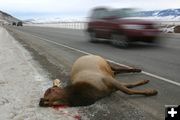

Road Kill Elk
A cow elk lay dead as motorists speed by on WY Hwy 89 north of Jackson recently. Photo by Mark Gocke, WGFD
|
|
Drivers: Beware of wildlife on roads
January 13, 2007
As winter weather pushes area wildlife down to winter ranges near valley bottoms, the Jackson Hole Wildlife Foundation (JHWF) and Wyoming Game and Fish Department (WGFD) are cautioning drivers about the hazards of wildlife crossing valley roads and asking drivers to slow down.
According to data collected by the Jackson Hole Wildlife Foundation, Grand Teton National Park, and the Wyoming Department of Transportation, at least 282 elk, moose and deer were killed on Teton County roadways in 2006.
Additionally, 12 bison, 1 gray wolf, 1 black bear and many small animals including red foxes, beavers, badgers, raccoons, owls and coyotes were also killed in collisions with vehicles. Drivers should use extra caution, particularly at night and during early morning hours.
Here are hotspots for wildlife in the Jackson area:
- Just north of Jackson, where elk are attempting to cross over in to the National Elk Refuge, on Highway 89 near the National Museum of Wildlife Art.
- WY Highway 390 (or Teton Village Road). Moose and elk have been moving back and forth across this busy, icy road on a daily basis.
- Three miles east of Hoback Junction near Camp Creek Inn, watch for bighorn sheep are commonly seen on the road
- On Broadway in the Town of Jackson, deer are continually moving from the butte, across Broadway and down to Flat Creek.
The Wildlife Foundation recently purchased two roadside message trailers notifying drivers of animals that have been killed in the area and encouraging them to slow down and be alert.
"We're very excited about the new message trailers," said Harrison. "And WYDOT has been a great partner on this project, keeping the messages fresh and moving the trailers around to the various hotspots. Obviously, this is the real advantage of these portable trailers and we've gotten a lot of positive feedback about them already. Our only problem is that we need more trailers!"
Tips for driving with wildlife in mind:
*Expect wildlife on our roads.
*If you encounter an animal on a road with high snow banks, allow the animals to move down the road at its own pace until it finds a place to jump off the road.
*Scan the sides of the roads for wildlife.
*Stay alert while driving and be prepared to stop.
*Wildlife crosses roads primarily during dawn, dusk and at night.
*If you see one elk, deer or moose along the roadway, you are likely to see more.
*If you see an animal on the road expect the unexpected. They do not instinctively know how to react to your car. Give the animal time and room to move off the road. Do not try to out-run it.
* If you see a wildlife crossing sign, pay attention. It is there for a reason.
|
